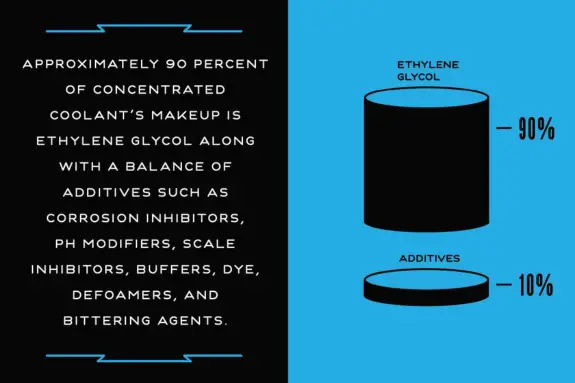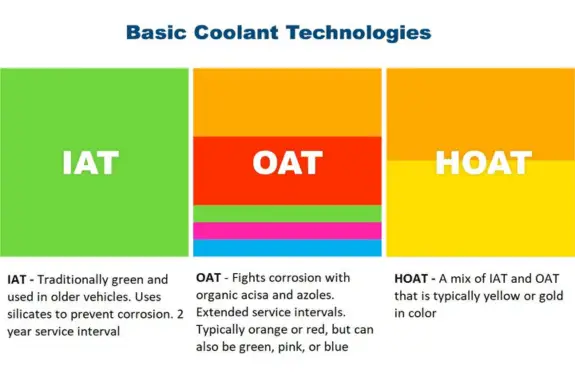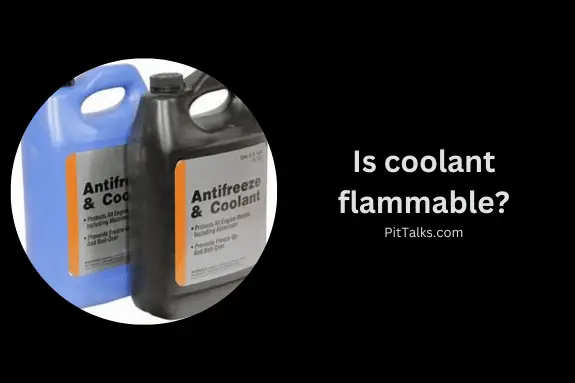Last Updated on August 19, 2023 by Pittalks
As a car owner or a mechanic, it is crucial to familiarize yourself with the various fluids that help your vehicle run smoothly. One such vital fluid is the engine coolant, often referred to as antifreeze. However, a critical question that often arises is: is coolant flammable?
This article aims to delve into the depths of this query, providing comprehensive insights on the subject while ensuring safety standards. So keep reading and let’s go!

Decoding the Composition of Engine Coolant
Before we delve into answering whether engine coolant is flammable, it’s essential to understand what constitutes this vital automotive fluid.
Defining Engine Coolant
Engine coolant, often interchangeably used with the term antifreeze, is a substance that regulates your engine’s temperature. It prevents the car’s engine from overheating during hot weather conditions and freezing during winters.
Engine coolant is essentially a blend of water and antifreeze. Antifreeze can be further classified into ethylene glycol or propylene glycol, both of which contain elements of alcohol.
What’s Ethylene Glycol or Propylene Glycol?
Propylene glycol is a clear, odorless liquid. It helps lower the freezing point and raise the boiling point of the coolant, ensuring efficient engine cooling.
Ethylene glycol is the component that lowers the freezing point, preventing coolant from solidifying. Although essential for engine protection, ethylene glycol is toxic if ingested, making proper handling crucial.
Different Types of Antifreeze
There are three primary types of antifreeze used in vehicles:
Inorganic Additive Technology (IAT): This type of antifreeze is often used in older cars and needs to be replaced every two years.
Organic Acid Technology (OAT): OAT is a newer form of antifreeze that contains only organic compounds, thereby offering longer life.
Hybrid Organic Acid Technology (HOAT): As the name suggests, HOAT is a combination of OAT and IAT, offering double protection against corrosion and rust.

Is Water Based Antifreeze More Flammable Than Synthetic Antifreeze or Coolant?
The choice between water-based antifreeze and synthetic antifreeze or coolant is relevant to understanding the flammability factor.
Considering the flammability aspect, water-based antifreeze is generally safer, making it a reasonable choice for most standard applications. However, in situations where extreme temperatures or high-performance demands are involved, synthetic antifreeze’s properties might be preferred, despite its potentially higher flammability risks.
The type of antifreeze used in your vehicle can influence the flammability factor. Here’s a comparison table showing the (estimated ranges) flash point of each coolant type, along with the flash points for each base component:
| Coolant Type | Flash Point Average (°F) |
|---|---|
| Water | 212°F |
| Ethylene Glycol | 250°F |
| Propylene Glycol | 230°F |
| Inorganic Additive Tech (IAT) | 300°F |
| Organic Acid Tech (OAT) | 300°F |
| Hybrid Organic Acid Tech (HOAT) | 300°F |
Dissecting the Flammability of Coolant
Now that we have a basic understanding of what constitutes engine coolant, let’s explore its flammable nature.
Is Coolant Flammable?
In simple terms, yes, engine coolant is a flammable liquid. However, the flammability is determined by several factors, including the concentration of antifreeze in the coolant, the temperature, and the presence of an ignition source.
The primary reason behind coolant’s flammability lies in its key component, glycol. Glycol, a clear sweet-smelling chemical, has a low freezing point, effectively extending water’s heat transfer range. However, this same attribute also makes glycol susceptible to ignition when exposed to high temperatures.
Here’s a video showing the flammability of coolant, performed in a “test and record” experimental format:
When Can Coolant Ignite?
Although coolant is flammable, it requires specific conditions to ignite. For example, in a car crash or a malfunctioning engine plug, a pre-existing coolant leak could expose glycol to a hot surface, leading to ignition.
Furthermore, the presence of water in the coolant increases its boiling point, making it difficult to ignite under normal circumstances. However, in extreme heat, the water can evaporate, leaving behind the flammable glycol, which, under the right conditions, can auto-ignite to cause a fire.
What is the Flashpoint of Antifreeze?
The flashpoint of a liquid is the minimum temperature at which it can ignite and give off vapor. For antifreeze, the official flashpoint ranges between 230° F and 270° F. This is significantly higher than the flashpoint for gasoline, which is only -40° F, but lower than diesel, which has a flashpoint of 120° F.
Here’s a table giving an overview of the flashpoints of most types of coolants as it pertains to this section:
| Fluid Type | Flash Point (°F) |
|---|---|
| Water | 212°F (100°C) |
| Ethylene Glycol | 250°F - 270°F |
| Propylene Glycol | ~230°F |
| Synthetic Coolants* | Varies |
Recognizing the Risk of Coolant Leaks
Understanding the risks associated with coolant leaks is crucial to prevent potential dangers, including fire.
Can a Coolant Leak Lead to Fire?
Yes, coolant leaks can potentially cause a fire if they come into contact with high heat, flames, or electrical sparks. This is because the leaked coolant can expose the glycol to the heat source, possibly leading to ignition.
In fact, a recent study confirmed that coolant leaks could be a primary cause of car engine fires. Thus, it’s crucial to address any coolant leaks immediately to prevent potential car fire hazards.
Preventing Coolant Fire Hazards
Given the potential fire hazards associated with coolant, it’s essential to handle it safely and monitor it regularly.
Safely Adding Coolant to Your Car
Similar to checking coolant levels, you should only add coolant to a cold car. Adding cold antifreeze to a warm engine could shock your vehicle’s cooling system, increasing the risk of leaks and damage.
Preventing Coolant Leaks
While there’s no foolproof way to prevent a coolant leak, understanding the warning signs can help detect potential leaks early.
Some common signs of a coolant leak include an above-average temperature gauge, a sweet odor, a flashing “Low Coolant Light,” issues with your car’s internal heating system, and frequent instances of steam or overheating.
The moment you suspect a car’s coolant may leak, get in touch with a trusted mechanic immediately. Ignoring a coolant leak can lead to severe engine damage and potential fire hazards.
FAQs and Related Questions
Is coolant flammable and pose a fire risk?
Yes, coolant can be flammable, posing a fire risk if mishandled, especially those with organic or hydrocarbon bases.
Any safety precautions when working with coolant?
Absolutely! Store flammable liquids and coolant away from ignition sources, use approved containers, wear PPE, enforce a no-smoking policy, and have fire extinguishers nearby.
Can the wrong coolant cause flammability issues?
Yes, using the wrong coolant can lead to increased flammability risks. Follow manufacturer guidelines for proper coolant selection.
What are non-flammable coolant alternatives?
Alternatives include water-based coolants, synthetic coolants with low flammability, and air-based cooling systems. Consider compatibility and consult experts for the best option.
Read more from the flammability series:
Is diesel flammable?
Is motor oil flammable?
Is power steering fluid flammable?
Is hydraulic fluid flammable?
Is trans fluid flammable?
Is brake fluid flammable?
Conclusion
So, is coolant flammable? Yes, under certain conditions. However, with proper storage, handling, proper disposal, and regular maintenance checks, you can minimize the risks associated with the flammability of coolant. Remember, safety should always come first when dealing with potentially hazardous substances like engine coolant.


